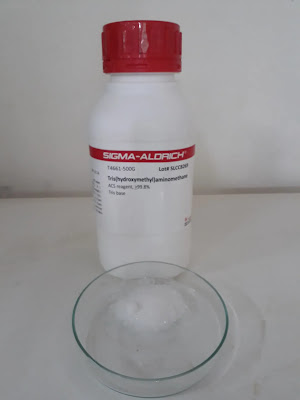CHEMICAL PRODUCT IDENTIFICATION
- Product Name: Tris(hydroxymethyl)aminomethane (TRIS-Base)
- Chemical Family: Organic compound.
- Signal Term: Warning!
- Read – TRIS-Base SDS!
COMPOSITION, INFORMATION ON INGREDIENTS
- CAS Number: 77-86-1.
- Synonyms: 2-amino-2-(hydroxymethyl)-1,3-propanediol, THAM,Tris base, Trometamol
- Component Name: Tris(hydroxymethyl)aminomethane.
- Formula: C4H11NO3 OR (CH2OH)3CNH2 OR NH2C(CH2OH)3
- Formula Wt.: 121.14
HAZARDS IDENTIFICATION
- Harm to the skin, significant eye discomfort, or corrosion.
- Irritates the skin & eyes severely.
- A single exposure to specific target organ toxicity; irritation of the respiratory tract.
- May irritate the respiratory tract(Remember).
- Avoid breathing fumes or dust.
FIRST-AID MEASURES
- Seek medical guidance or treatment.
- If Inhaled: Take the person outside & keep them resting in a breathing-friendly position.
- If in the Eyes: Rinse carefully for a few minutes with water. If contact lenses are present & simple to remove, do so. Rinsing continues.
- If on the Skin: Use lots of water to wash.
- In the case of skin irritation: Seek medical guidance or treatment.
- If Swallowed: Mouth should be rinsed with water. If you are not feeling well, contact a doctor.
FIRE-FIGHTING MEASURES
- Keep away from heat, sparks, & open flames(toxic gases could be released during decomposition when heated).
- Use water, foam, or CO2 to extinguish.
- TRIS-Base isn’t flammable or explosive.
ACCIDENTAL RELEASE MEASURES
- Delete all sources of ignition.
- Ventilate the area.
- Don’t let solid go airborne.
- Clean up, put in a container or sealed bag, & throw away.
- After material pickup is complete, clean the spill scene.
HANDLING & STORAGE
- Store alongside amides, amines, glycols, & alcohols.
- It is a Hygroscopic.
- Keep the contents of a chemical safety bag in a cold, dry location.
- Keep the container firmly shut.
- Use only in a well-ventilated room or under a hood.
EXPOSURE CONTROLS, PERSONAL PROTECTION
- Wear appropriate eye protection, gloves, & clothes.
- After handling, carefully wash your hands.
- Use only in a well-ventilated room or under a hood.
PHYSICAL & CHEMICAL PROPERTIES
- Appearance: Solid white crystals. Odorless.
- Soluble in: alcohol & water.
- pH: 10.4 (in 0.1 Mol / l).
- Boiling point: 219°C.
- Melting point: 175°C.
- Boiling point(initially): 219°C-220°C.
STABILITY & REACTIVITY
- Avoid coming into contact with oxidizers and bases.
- Hygroscopic, poor shelf life.
TOXICOLOGICAL INFORMATION
- Acute Effects: irritating to the skin, eyes, & respiratory system.
- Chronic effects: N.A
- Targeted Organs: eyes, skin, & respiratory system.
- LD50 for ORL-RAT: 5900 mg/kg
- LC50 for IHL-RAT: N.A
- LD50 for SKN-RBT: N.A
ECOLOGICAL INFORMATION
- The substance isn’t a serious environmental pollutant & does not accumulate in the environment. It doesn’t persist in the environment and is not known to be hazardous to aquatic organisms.
DISPOSAL CONSIDERATIONS
- Dispose of in accordance with local, state, & federal regulations.
TRANSPORT INFORMATION
- Name of Shipment: Not regulated. Hazard class: N/A. UN number: N/A.
REGULATORY INFORMATION
- TSCA & EINECS listings (201-064-4).
OTHER INFORMATION

Tris(hydroxymethyl)aminomethane (TRIS-Base) is an organic compound used as a buffer in biological research, particularly in molecular biology, biochemistry, and genetics. It is also known as Tris base or Tromethamine.
CONCLUSION
In biological research, particularly in molecular biology, biochemistry, & genetics, the chemical molecule tris(hydroxymethyl)aminomethane (TRIS-Base) is employed as a buffer. When carrying out necessary laboratory precautions & protocols, such as donning the proper personal protective equipment, labelling the substance properly, & disposing of it properly, it is typically safe to handle. When handling any laboratory reagent, including TRIS-Base, it’s critical to constantly adhere to good laboratory practices & standard operating procedures as well as to utilize the appropriate personal protective equipment. Please seek emergency medical assistance if any unfavourable reaction takes place. Since it is neither flammable nor explosive, you may put out a fire with water, foam, or CO2. One must follow TRIS-Base SDS before handling this product.
